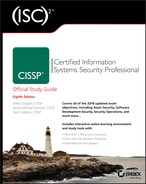Book Description
CISSP Study Guide - fully updated for the 2018 CISSP Body of KnowledgeCISSP (ISC)2 Certified Information Systems Security Professional Official Study Guide, 8th Edition has been completely updated for the latest 2018 CISSP Body of Knowledge. This bestselling Sybex study guide covers 100% of all exam objectives. You'll prepare for the exam smarter and faster with Sybex thanks to expert content, real-world examples, advice on passing each section of the exam, access to the Sybex online interactive learning environment, and much more. Reinforce what you've learned with key topic exam essentials and chapter review questions.
Along with the book, you also get access to Sybex's superior online interactive learning environment that includes:
- Four unique 250 question practice exams to help you identify where you need to study more. Get more than 90 percent of the answers correct, and you're ready to take the certification exam.
- More than 650 Electronic Flashcards to reinforce your learning and give you last-minute test prep before the exam
- A searchable glossary in PDF to give you instant access to the key terms you need to know for the exam
Coverage of all of the exam topics in the book means you'll be ready for:
- Security and Risk Management
- Asset Security
- Security Engineering
- Communication and Network Security
- Identity and Access Management
- Security Assessment and Testing
- Security Operations
- Software Development Security
